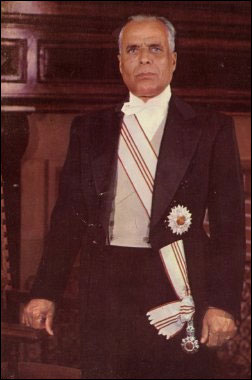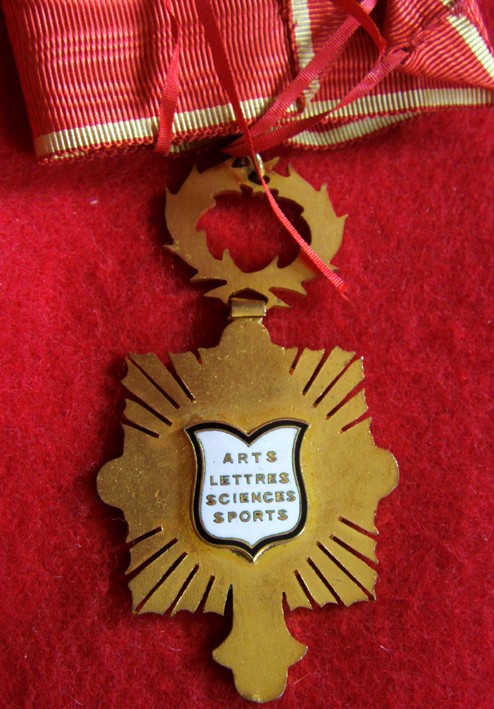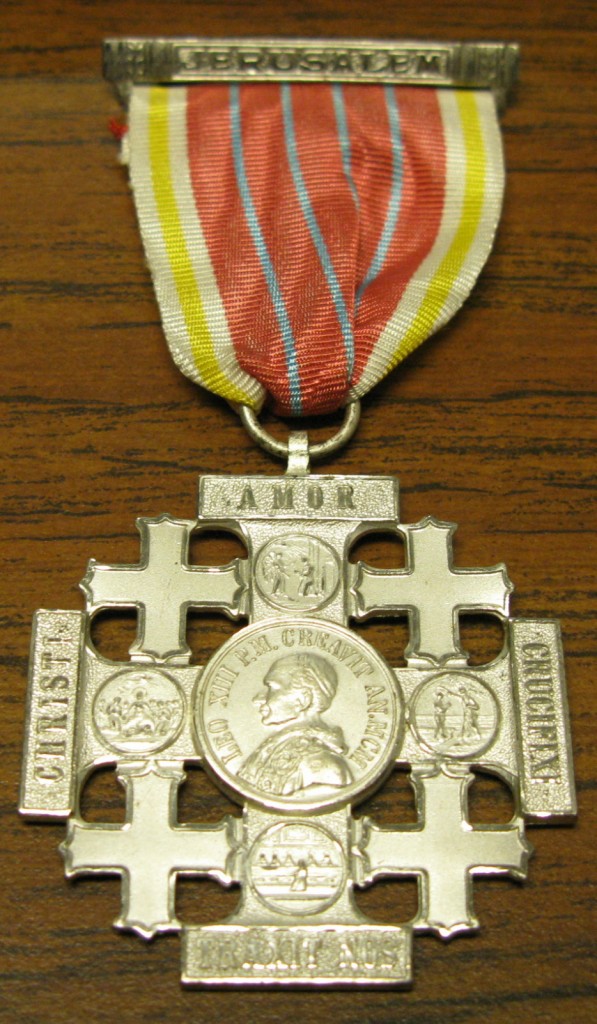
922F
-
Posts
1,384 -
Joined
-
Last visited
-
Days Won
7
Content Type
Profiles
Forums
Blogs
Gallery
Events
Store
Posts posted by 922F
-
-
Alexander I monogram on case lid. If about 60 X 80 mm in size, similar cases held an Order of Bravery breast badge; could be 3rd or 4th class. If 70 X 110 mm in size ,or thereabouts, would be for a 2nd class neck badge. Image indicates case contains at least a correct Order of Bravery ribbon.
0 -
Green ribbon may signify Italian Maurice & Lazarus, commander grade [gilt crown device on ribbon]. Sacred Treasure fairly rare on such bars. It looks well assembled--have you UV lighted it?
0 -
Paul, الإستقلال translates as "Istiqual" or "Istiqlal" -- Independence.
The original September,1956 statutes described insignia as the same as that then current for the Nichan Iftikhir -- later [December, 1956?] revisions supposedly replaced all green enamel where it exists in Nichan Iftikhir insignia with red enamel. It appears that very few pieces with all red enamel and the Bey's name in the center have been seen -- they may be mules or fabrications made on behalf of various pretenders to the Beydom or for collectors.
Next, maybe July 1957, with proclaimation of the Republic, the Tunisian coat-of-arms replaced the Bey's name, the bow suspension disappeared [sometimes!] from the lower classes, and the ribbon became white with 3 central red stripes and a red stripe at the edge. Some insignia bears the word الإستقلال along the bottom of the "motto ring".
The word الإستقلال [Independence] replaced the coat-of-arms in 1959 era statute revisions and the ribbon changed to red with 2 white edge stripes in a pattern similar to the Nichan Iftikhir.
References sometimes muddle these changes: Werlich's second edition appendix "A", naturally, describes 1970s insignia & Burke switches image captions.
Though Bourguiba gave lip-service to the monarchy during the independence struggle, it was clear that he intended to replace it with a republic [led by him for over 30 years!] as soon as possible after independence from France. Image below shows him wearing a 2nd type [1957 Republic] grand cross set.
 0
0 -
Likely a local souk made, second type [1956] Tunisian Order of Independence star. Maybe altered from a Nichan Iftikhir star? Order of Independence Insignia obviously copied from Nichan Iftikhir. Red enamel usually darker and principal star rays red enameled as well. (c.f. Royal Ark website---[http://www.royalark.net/Tunisia/orders.htm]. Image there apparently made from reversed 'negative', so central inscription in mirror image.)
0 -
Saw such points on poles likely dating from the 1910s-50s; hard to be more precise on date span, could be even earlier. Sometimes poles [2 to 6] with these finials were mounted behind a shield of national colors used to fly flags displayed for holidays, parades or state visits.
In the 1970s-90s, one could find job lot boxes [10 or 20 in a box] of this type ornament or finial in Paris & Brussels flea markets and elsewhere priced at about the equivalent of 50 cent to 2 euros each. Like yours, they sometimes have insignia or initials embossed in the oval cartouche, usually are one-sided [embossed so high relief on one side and mirror image on other] and generally are very flimsy, metal about the gauge of a steel can lid or slightly less. A maker's name may appear on an edge near the bottom ferrule.
Do not know if they are currently used/made. Suspect present counterparts are made of a more durable, likely cheaper plastic.
0 -
Forum member 'oamotme' published a study of Kathiri awards, including reference to design similarities with "Schlaraffia" materials. Don't remember if his work appeared here or in an OMRS or OMSA publication. Due to possible copyright issues, suggest you get directly in touch with him for complete information. Perhaps he could post a digest in the Arab states thread?
0 -
RE Taras' 169 post above
The Republic of Italy's Order of Merit insignia change [Decree of the President of the Republic No. 173 of 30 March 2001] reportedly stemmed from then PM Amato's fascination with the Italian royal Order of the Crown.
from:

to

based on this:

Off topic--but see Owain's discussion of the Sultanat Kathiri decoration's insignia basis or 'descent' from the "Schlaraffia" German society insignia.
0 -
Fascinating, highly useful information--Thank you Nick!
0 -
Has this decoration been faked? The crowns in the upper cross arm obverse of the pieces illustrated seem somewhat different. Apparently there are silver and gilt specimens around... Thanks for any assistance.
0 -
Ruiz,
Excellent selection of awards in great condition with some especially interesting regency/republic award envelopes! . . . congratulations!
Regarding your ribbon bar, candidates for the Bulgarian Bravery ribbon include the Order of Merit & merit medals as well as Bravery Order/medal and wartime awards of the 'Military Merit Order'. Red ribbon with swords is likely a St. Alexander knight [with or without crown] with swords through the middle. In usual precedence, a St. Alexander award would follow the Bravery Order and first [golden] grade, Order of Merit but precede Bravery cross, equivlent or lower grade of Military Merit Order, 2nd [silver] grade, Order of Merit and Merit Medal on military ribbon.
Image shows a Boris emission Order of Merit, military division, 2nd class:
0 -
-
Megan is correct -- Décoration de la Ligue Républicaine du Bien Public. For more, Google Ligue Universelle du Bien Public
0 -
This likely is an ephemeral Order of St. Tatiana insignia. It is probably not enameled on the reverse. Identification based on ribbon color and the red enamel of the cross. At least the Roman Catholic and Russian Orthodox faiths recognize St. Tatiana as Patron Saint of Students.
This Order apparently dates from the 1980s, was given in exchange for 'donations to a worthy cause' and may no longer exist.
0 -
Artan's identification is correct. The statutes, according to Klietmann's Ordens-Lexicon, prescribe a silver badge for officers and a bronze-gilt badge for knights. Many sources confuse the issue by assuming that gold color insignia outranks silver color and thus misidentifying grade badges. Mulder and Christiaans [Onderscheidingen van de Balkan, 2008] report that both Captain Jan Fabius and Mayor Joan Snellen van Vollenhoven {Herr General's post 105 above} received an officer grade of the Order, further confirming Klietmann.
Nonetheless, Klietmann's published number of Black Eagle Order awards is completely wrong. As reported elsewhere in this and other threads, the numbers actually are much greater than he cited. Primary sources including Armstrong-Heaton's The Six Month Kingdom, 2005, and Peter Mulder's work as well as Rrumbullaku's Dekorimet, 2010, indicate that a considerable number of additional awards were made both in Albania and in exile up to about 1922.
0 -
Your excellent knight's badge: A great addition!!! Have you looked under the pad? Though usually ribbon storage only, sometimes there's a note or other marking. Found in Venna?
0 -
As usual, Elmar is quite correct. A noble descendant of Skenderbeg resident in southern Italy founded & awarded several orders as well as titles during the 1880s-1900s. The Italian government of the time appears to have recognized his noble descent and princely title, at least.
The orders included an “Order of Epirus”, “Order of Skenderbeg” and “Order of the Orient”. A bestowal document clearly indicates that each of these orders were distinct entities. French, Italian, Spanish, and possibly other nationals received, qualified for or otherwise obtained these awards.
Sources including Gillingham’s Ephemeral Orders [1935] & a recent ANS auction catalog identify a star comparable to that illustrated in the catalog under discussion as being “Order of Epirus” insignia. Though very likely an uncommon decoration, the pieces are not ‘one off’ insignia. At least three similarly constructed stars, one other sash badge and an identical badge fitted with a neck cravat suspension exist in private collections.
0 -
Fine book. Even with 37 to 37 Euro postage fee to U.S.A., is much less than original book cost & one had to pay postage for that as well!!
0 -
Matt,
Among others, Claudio's source [http://www.medals.pl/ro/ro1.htm] illustrates:

Order of the Queen Marie Cross
(Ordinul "Crucea Regina Maria") (1938 war ribbon)
Cross of Sanitary Merit
(Crucea "Meritul Sanitar") (1938 war ribbon)See also ebay lot 231065220832 for an example of a war time Queen Marie 3rd class award plus brevet on war ribbon. It seems clear that both the Order of Queen Marie and the Cross for Sanitary Merit could be awarded on a 'war ribbon'...gold thread edges in these instances.
Claudio,
The Romanian Star ribbon bears a rosette. Cultural Merit Order Literary ribbon appears at http://www.medals.pl/ro/ro1.htm as:

Order of Cultural Merit - literature - Cmdr, Of, Mem1, Mem2
(Ordinul "Meritul Cultural") (1931)Our subject's 6th ribbon side stripes seem configured differently from the Cultural Merit Order, Literary Division. That ribbon color appears to be light blue with dark [toned metallic?] side stripes. This reasoning underlies my post 3 identifications above.
Of course, it may be completely possible, as Matt suggests, that the ribbon bar assembler simply used what ribbon stock 'best matches' came to hand.
Cheers
0 -
Appears that an Order of the Romanian Star [war ribbon] officer [rosette on ribbon], Romanian Queen Maria Cross [crossed swords/war ribbon/-verify gold thread on edges] lst class, Bulgarian Bravery Order [check ribbon for metallic silver threads in stripes--could be for either the Bravery Order or Bravery Cross or a war ribbon for the Order of Military Merit], Romanian Crusade Against Communism medal, and Turkish Iron Crescent ribbons follow his 3 German award ribbons.
0 -
Another tour de force Nick. Mitya's contributions round out the exposition. Sincere thanks to you both!
0 -
Thank you for showing these groups Nick!
Besides the hooks [likely salvaged from ribbon attachments shown in post 12] that slip into loops sewn on tunics Austrian style, have seen a couple of groups made up like #12 lower image with black metal 'male snap-pins' attachments. Three or four male 'snap-pins' [about 7 mm in diameter with the male side sewn to the bar back] served to fasten a 3 to 5 medal group to clothing.
Suspect these were home-made for civil dress or fairly static display as the female 'snap-pin' would perhaps compromise a uniform's appearance? The 'snap-pin' approach appears a much less secure attachment method in any case.
0 -
Is there card or fibreboard under the ribbons? If so, in [sloppy] sewing/mounting style at least, have seen a couple of similar groups at the Sofia flea market. These others usually had a long pin and catch attached to the backing material through the ribbons. Hard to say if original veteran assembly or put-together; style certainly not proper for active service wear.
Ribbon wear overall seems inconsistent, 1,000 anniversary medal usually on a red/white/green national color ribbon & not properly worn with national medals but who knows?
0 -
Nick,
Thank you encore une fois!! Here's a bit more information regarding /安井藤治 and his career located at http://generals.dk/general/Yasui/Toji/Japan.html.
Cheers, EJ
1926- 1929
Attached to Chief of Mobilization Section, Econmic Mobilization Bureau, Ministry of War
1929- 1931
Chief of Mobilization Section, Econmic Mobilization Bureau, Ministry of War
1931- 1933
Commanding Officer 2nd Imperial Guards Regiment
1933- 1934
Chief of 9th Section (Military History), 4th Bureau, General Staff
1934- 1935
Commanding Officer 29th Brigade
1935 - 1937
Chief of Staff Tokyo Defence Command
1935- 1937
Chief of Staff Eastern Defence Army
1937- 1938
Commanding Officer 5th Independent Garrison
1938- 1939
General Officer Commanding 2nd Division
1939 - 1941
General Officer Commanding 6th Army
1941 Attached to the General Staff
1941 Retired
1945 Minister of State
0 -
Hi Nick,
Thank you [and Stas!] for the information on Yasui Todzi /安井藤治 (1885-1970)--post 232 above. I am unfortunately ignorant of the Japanese language and possible name variations. Searching for /安井藤治 led to Yasui Fujii. Are Yasui Todzi and Yasui Fujii the same individual? Below is what I find on Yasui Fujii, seeming to suggest reasons/time period for his Balkan awards. Could you please correct or amplify? Sincere thanks!
Eldest son of a businessman, Yasui Fujii attended Toyama high school and Nagoya army regional school through February 11, 1905. Graduated from the Army cadet school with honors. Became an infantry Lieutenant {regiment 35} February 11, 1913. In 1916, staff officer, Military Affairs Bureau. From1919, monitoring peace treaty implementation as member Committee in Eastern Europe. In 1926, promoted army infantry Colonel at division level; 1929 became a mobilization Bureau Chief. Then he served as guards infantry no. 2 commander until 1931. In 1934 promoted to Maj. Gen. and appointed infantry regiment 29 commander. In 1935, served in Tokyo where he led in the pacification of several incidents. Promoted to Lieutenant General 1937 commanding No. 5 National Guard; 1939 6th Army commander. In 1942, served in Tokyo, General Staff and appointed as Minister of State {Army} in the1945 Suzuki Cabinet.
0




Vatican Benemereti Cross
in Southern European & Balkan States
Posted
Pieter is correct-- see also: http://www.coins-la-galerie-numismatique.com/decade-auction/vatican/pope-leo-xiii-commemoration-holy-year-1900-1901-silver-bene-merenti-medal and credit for design to R. F. Marshall of Vienna: http://books.google.com/books?id=YQsrAAAAMAAJ&pg=RA4-PA168&lpg=RA4-PA168&dq=Pope+Leo+XIII++medal+++Holy+Year+1901,&source=bl&ots=ltevWpTKjG&sig=4DN2U1ANv6GiXczpT0gyIlUCfHI&hl=en&sa=X&ei=ZD2ZUuCxJcH7oASmyYGICA&ved=0CDsQ6AEwAQ#v=onepage&q=Pope%20Leo%20XIII%20%20medal%20%20%20Holy%20Year%201901%2C&f=false
Ribbon is a design & colors similar to that of the Medal of the Holy Land (image below) founded bu Leo XIII (Dec SCPF May 2, 1901) to commemorate pilgrimages.
)